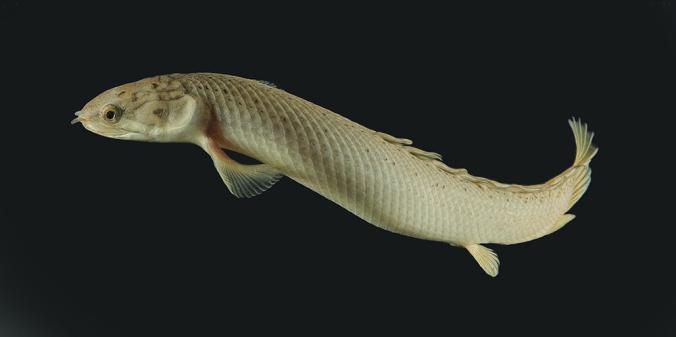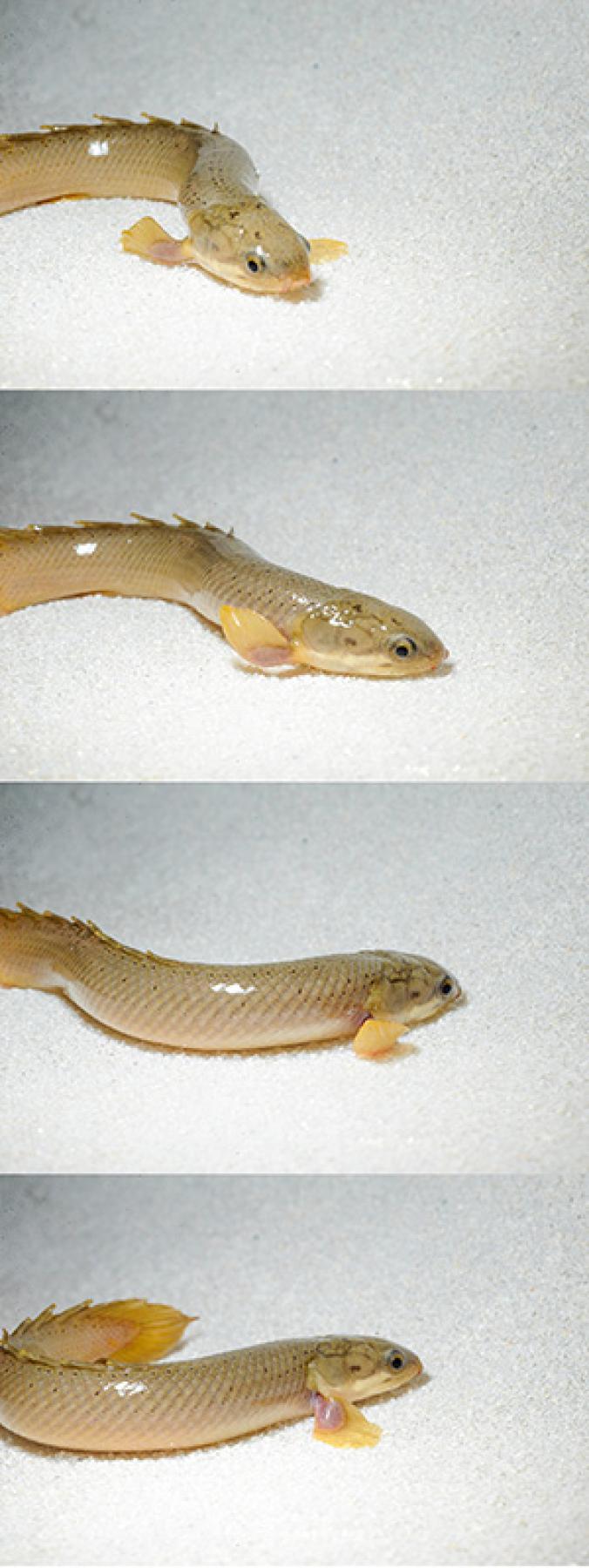
If you explore our genealogy back beyond about 370 million years ago, it gets fishy. Our ancestors back then were aquatic vertebrates that breathed through gills and swam with fins. Over the next twenty million years or so, our fishy ancestors were transformed into land-walking animals known as tetrapods (Latin for “four feet”).
The hardest evidence–both literally and figuratively–that we have for this transition comes from the fossil record. Over the past century, paleontologists have slowly but steadily unearthed species belong to our lineage, splitting off early in the evolution of the tetrapod body. As a result, we can see the skeletons of fish with some–but not all–of the traits that let tetrapods move around on land. (I wrote about the history of this search in my book At the Water’s Edge; for more information, I’d suggest Your Inner Fish, by Neil Shubin, who discovered Tiktaalik, one of the most important fossils on the tetrapod lineage.)

You can get a feeling for how fish became tetrapods by looking at a fossil like Tiktaalik, shown here. These days, a lot of scientists are turning up clues about how a fish turned into this kind of creature, and how this kind of creature turned into creatures like us.
Along the way, a lot of genes changed. The genes in the egg of a fish encode the molecules that will produce the fins, gills, and all the rest of a fish’s body. A different set of genes will produce a tetrapod. These days, scientists are finding some of the mutations that reprogrammed fins into feet.
But a new study in Nature puts a fascinating new wrinkle on our origins story. It suggests that our fishy ancestors already had the potential to develop the beginnings of a tetrapod body. They just needed some time on land to bring it out.
The authors of the new study, three scientists at McGill University in Montreal, studied fish called bichirs (Polypterus). Bichirs are the living remnants of a very old lineage of fishes, which split off from other fish lineages some 400 million years ago. While they mostly live in lakes and rivers, they will sometimes crawl across dry land with their fins. They can even sustain themselves on these journeys by breathing through primitive lungs. Here’s a video of how they walk.
The McGill researchers saw some intriguing parallels between bichirs and early tetrapod relatives like Tiktaalik. Bichirs use their front pair of fins to lift their head and the front end of their trunk off the ground. They then push the back end of their trunk in order to propel themselves forward. Tiktaalik may have moved in a similar fashion.

But bichirs spend relatively little time on land. The McGill scientists wondered what would happen if they forced the fish to grow up out of the water. To find out, they reared 111 bichirs in a terrarium with a pebble-strewn floor. To prevent the bichirs from drying out, the scientists installed a mister to keep their skin moist. The fish grew for eight months, clambering around their terrarium instead of swimming.
Then the scientists examined these fish out of water. They found that eight months on dry land (or at least moist land) had wreaked profound changes to the bichirs.
For one thing, they now walked differently. Overall, they were more efficient. In each step, they planted their fins on the ground for less time, and they took shorter strides. Instead of flapping their fins out to each side, they placed their fins under their bodies. Their fins slipped less when they pushed off of them. They made smaller movements with their tails to go the same distance as a bichir raised underwater. Aquatic bichirs walk on land with an irregular gait. The terrestrial bichirs, on the other hand, walked more gracefully, planting their fins in the same spot relative to their bodies time after time.
The bichirs probably developed this new walking style in large part through learning. Growing up on land, they had more opportunity to test out their moves and to perfect the best ones. But it wasn’t just their brains that changed on land. Their bodies changed, too.
The McGill scientists examined the bones of the terrestrial bichirs and compared them to normal aquatic ones. They found striking differences in the bones, especially in the shoulder region. Some of the bones had become less tightly connected to each other, giving the bichirs more room to swing their fins as they walked. By contrast, their bones corresponding to our collarbones became bigger and more strongly braced, letting the animals resist gravity and lift their bodies higher.
It was the experience of walking that changed the fish bones. The forces exerted on them changed how the bone cells grew, leading them to take on new shapes. What’s especially intriguing about these changes is that they’re a lot like the changes paleontologists have documented in tetrapod fossils.
Over millions of years, our fishy ancestors evolved looser connections between some shoulder bones, enabling their legs to sweep bigger motions and also starting to separate the head from the neck. They also evolved stronger support systems for their trunk so that they could lift themselves out of the muck. It’s as if the bichirs are replaying evolution in their own lifetime.
This is not the first time that biologists have found tantalizing parallels between the experiences of individual animals and long-term evolution. The environment in which animals grow up can steer the development of their bodies, and then evolution can follow suit.
In 2008, for example, scientists raised stickleback fish on two different diets. One group of fish ate bloodworms squirming around at the bottom of their tanks. The other fish ate shrimp scooting around in the open water. The bloodworm-eating fish had to clamp down on the blood worms to eat them, while the shrimp-eating ones just needed to sneak up on their prey and swallow them with a quick slurp.
The result of these different movements was different heads: the bloodworm-feeders had short, wide mouths, and the shrimp-feeders had long, narrow ones.

These sticklebacks, which are abundant in the ocean, have repeatedly colonized lakes. As they’ve adapted to their new freshwater home, they’ve evolved over and over again into two distinct populations. Some of them scrounge on the lake bottoms for prey, while the others zip around the open water. And time and again, they’ve evolved wide short mouths, or narrow long ones. Evolution has followed the path of experience.
The ability that animals and plants have to develop differently in different conditions is known as plasticity. It’s possible that plasticity opens the door to new paths that evolution can then take. When organisms find themselves in a new environment, they develop in a way that helps them cope with their new surroundings. Their descendants may acquire mutations that encode that anatomy in their genes. Eventually evolution takes them beyond where plasticity alone could take them.
This kind of experience-led evolution, known as genetic assimilation, might have helped take our ancestors out of the water. The forerunners of tetrapods might have been forced to scoot over dry land more than their ancestors–to flee predators in the water perhaps, perhaps to mate, perhaps to get to other streams and ponds. Their underwater genomes gave them the plasticity to grow into halfway decent walkers, like bichirs do today. And then subsequent mutations gave them an improved anatomy. They didn’t have to grow into walking: their genes had now taken over the job, and our ancestors were ready to walk on.
[Correction: I updated the post to the correct number of bichirs in the study.]